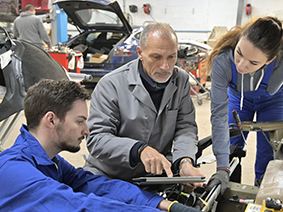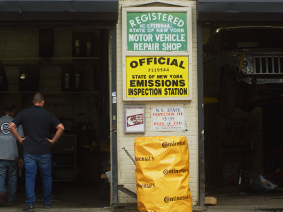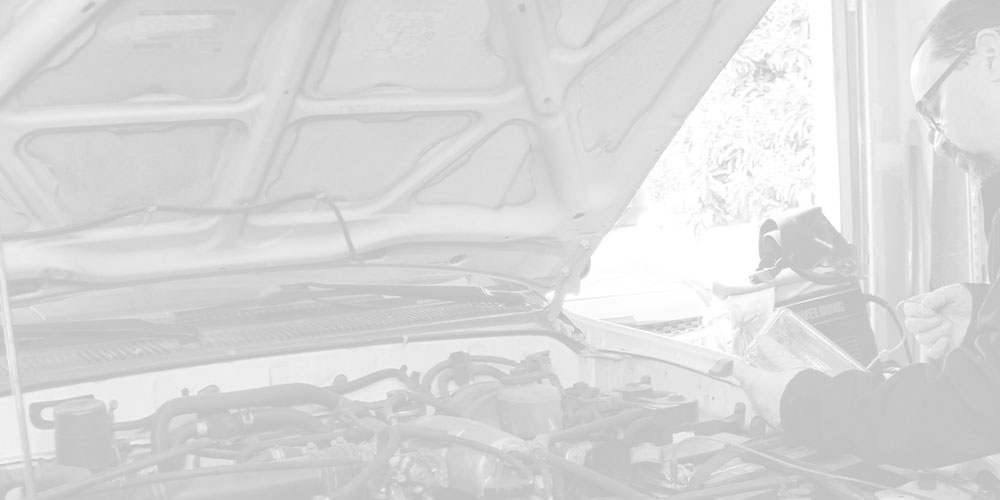Vehicle: 2011 Chevy Express 3500 6.6L Turbo Diesel, Automatic Transmission/Transaxle
Mileage: 65,000
Problem: The truck had a diagnostic trouble code, P20EE (NOx catalyst efficiency below threshold), and no other symptoms. The diesel exhaust fluid (DEF) had not become contaminated.
Vehicle: 2012 Dodge Charger RWD V6-3.6L Automatic Transmission/Transaxle (Police model)
Mileage: 178,000
Problem: The blower motor operated with ancillary power and ground provided but the blower module was not getting a signal from the HVAC module. The tech found the following communication and voltage codes in all modules: B10E8, B11C2, B210A, B210B, B210C, B210D, B210E, B2199, B21DD and U0010.
Vehicle: 2007 Land Rover LR3 (LA) V8-4.4L Automatic Transmission/Transaxle
Mileage: 112,003
Problem: After replacing the battery, the customer noticed the rear suspension was lower than normal. The tech retrieved a DTC C1131 – Air Spring Air Supply code from the Suspension Module.
Vehicle: 2005 GMC Truck Sierra 1500 4WD V8-5.3L VIN T Automatic Transmission/Transaxle
Mileage: 115,662
Problem: Truck was running fine and then one morning it would not start and the instrument cluster displayed a “Reduced Power” message. The MIL was ON.
Vehicle: 1999 Dodge Intrepid V6-2.7L VIN R Automatic Transmission/Transaxle
Mileage: 226,000
Problem: Vehicle will run with cam sensor disconnected – but it's rough and misfiring. Vacuum gauge needle is bouncing and vacuum is very low.
Did you hear the one about the vehicle that collided with a collision shop? No joke… It really happened in Texas in early 2014. An SUV demolished a collision shop’s wall and ended up on its roof inside a storage area. No word on whether or not that particular shop was selected for the repair.
Most vehicles probably do not enter your shop in such a dramatic fashion. But what IS dramatic is the way vehicles are being constructed these days. Cars and trucks built with new materials – advanced steels, aluminum, carbon fiber, and plastics have replaced those heavyweight steel models that used to rule the roads.
Vehicle: 2001 Pontiac Grand Prix, V6-3.8L, VIN K, Automatic Transmission/Transaxle
Mileage: 138,446
Problem: This vehicle came into the shop with DTC P0404, which sets again immediately after clearing the code. The customer noticed the engine stumbles on mild acceleration.
Vehicle: 1997 Ford Truck Ranger, 2WD, V6-3.0L, VIN U, Automatic Transmission/Transaxle
Mileage: 198,775
Problem: Truck had DTCs P0135, P0141 & P0155. The vehicle ran well but the customer’s concerns were the MIL was on and there had been a noticeable drop in fuel economy.
Vehicle: 1996 Honda Civic Sedan, L4-1.6L SOHC (VTEC), Automatic Transmission/Transaxle
Mileage: 206,886
Problem: The engine cranks normally but would not start.
Vehicle: 2008 Ford F 150, 4WD, V8-5.4L Flex Fuel, Automatic Transmission/Transaxle
Mileage: 74,332
Problem: The fuel gauge does not read the correct fuel level. DTCs B1201 and P0463 are set. The tech checked the wiring between the sending unit and instrument cluster and found no problems. The fuel gauge sending unit was replaced – same problem.
Vehicle: 2010 Kia Forte, L4-2.4L, Automatic Transmission/Transaxle
Mileage: 35,416
Problem: The transmission will not shift out of the park position. You can’t command it to unlock with scan tool. No DTCs.
Vehicle: 1994 Ford Truck Ranger, 4WD, V6-245 4.0L, Automatic Transmission/Transaxle
Mileage: 206,002
Problem: The cruise control will not hold a steady speed and the throttle pedal is visibly moving up and down. The truck runs smooth when not in cruise control. No DTCs.
Vehicle: 2006 Dodge Ram 1500, 4WD, V8-5.7L, VIN 2, Automatic Transmission/Transaxle
Mileage: 94,587
Problem: Vehicle had DTC faults: P0335 for crankshaft position sensor, P0642 for sensor reference voltage 1 circuit low and P2122 for APP sensor circuit. The engine also lacked power.
Vehicle: 2006 Mini Cooper S, L4-1.6L SC, Automatic Transmission/Transaxle
Mileage: 112,002
Problem: Vehicle had DTC P1688 (Electronic throttle control monitor level 2/3; mass air flow calculation) and low power. We found that an intake duct clamp was loose so we cleaned the throttle body and refitted the boot and tightened the clamp – no change. One of the techs found a TSB addressing the P1688 DTC, which said not to replace the DME control module without further testing of the supercharger bypass valve. The valve was good, but the TSB prompted further diagnosis.
Vehicle: 2006 Nissan-Datsun® Sentra®, L4-1.8L (QG18DE), Automatic Transmission/Transaxle
Mileage: 92,336
Problem: The idle speed is consistently too high. The tech found poor connections at throttle body and repaired connector. After reconnecting throttle, the idle was still high.
Vehicle: 2013 GMC® Yukon® XL, 4WD, 5.3L, Automatic Transmission
Mileage: 88,005
Problem: DTC B0085 00 – Left Front Impact Sensor Circuit High or Low
We have recently noticed an increase in oil pressure switch-related problems with late model Honda® vehicles. Two switches that seem to be consistently problematic are the rocker arm oil pressure switch  and the engine oil pressure switch. Each exhibits its own unique symptoms, but the fix is the same for both – replace them.
and the engine oil pressure switch. Each exhibits its own unique symptoms, but the fix is the same for both – replace them.
By ALLDATA Staff
“I hear a noise!” That’s a customer complaint that might encourage you to suddenly take a long lunch. But before you run off for a BLT, check a TSB! Conditions, such as random noises, are often already known by the manufacturer, and a solution may be available. TSBs (technical service bulletins) are just a few clicks away when you subscribe to OEM repair information.
By The ALLDATA Staff
Diagnosing an unfamiliar condition without OEM information can take time and cost your customers money. You may save both time and money by first consulting a vehicle manufacturer’s technical service bulletins (TSBs). When a fix for a known issue is already published, it’s a win-win for everyone. Here’s an excerpt from a TSB issued by Chrysler dealing with a steering problem on certain 2009 Chrysler® and Dodge® vehicles.
It can be scary when your steering system makes unexpected noises. Drivers might be concerned about steering failure, and about getting up close and personal with an immovable object. Steering failure is right up there with brake failure when it comes to registering fear while driving.
A noisy steering scenario exists with certain Toyota® vehicles. Toyota knows about it and has issued the following technical service bulletin (TSB) to identify and correct the problem. If you see a vehicle with this condition in your shop, follow the procedures in this TSB:
The collision industry amazes me. Mostly in a good way. Today’s rapidly changing technologies keep things interesting. New materials, such as ultra high strength steel, plastics, composites and other materials offer up challenges we didn’t have to deal with in “the good old days.”
But perhaps the most challenging aspect of repairing newer vehicles remains the ever-increasing use of electronic systems. We no longer see “cars” in the shop, we see rolling computers.
Mike is a great guy who runs a collision repair facility in Joliet, Illinois. We’ve always had a good relationship and he never holds back when we talk. Good or bad, you’ll get exactly what you asked for – complete honesty.
Mike had only been using OEM repair information for a couple of weeks, so I called him looking for some feedback. I was not expecting to hear what he told me. I specifically asked him how he was doing using OEM repair information in his shop’s workflow. Mike told me that in the short time he had been using factory information, it had already saved his shop from having a serious delivery issue. And Mike has always taken pride in delivering vehicles to their owners on time.
Some Mazda® B-2500® drivers may complain of a high idle in vehicles with a manual transmission. This may be caused by a poor electrical connection at the wire harness to the throttle position sensor (TPS). A service kit is available to resolve this concern. Correct the condition by following the steps in this Tech Tip.
Applicable Model
All 1998-2000 Mazda B-2500 Trucks with manual transmission
Parts Information
One Friday, I stopped into a friend's shop to discuss going over to Serino’s Deli® for lunch. Instead, Mike drags me into the shop. I was hungry and I'm thinking this better be some exotic car if Mike is jeopardizing our ability to get a table at the deli.
The car is a 2009 Chevrolet® Malibu®. Not exactly exotic. Mike tells me, "The front fender was damaged and no one was in the car." The problem is that the air bag light is coming on intermittently. Mike has already spent four hours diagnosing the issue and they can't deliver the car with the light on. Did I mention it was Friday?
Our lunch plans were now in serious jeopardy.
Radar – really? If you haven’t seen it in a crunched car yet, you are probably overdue. Vehicles utilizing this technology invented for ships and planes are now rolling (or being towed) into shops as a result of collisions. To repair these vehicles efficiently and profitably, you need to understand the specific nuances of each manufacturers’ advanced systems for collision avoidance, adaptive cruise control and parking assist.
As with any new system that proves successful, radar technology is sure to become widespread throughout the industry. The safety and convenience factors are simply too great. The National Transportation Safety Board already recommends that all new cars include collision avoidance and adaptive cruise control systems.
A new car is in the shop, and the front end looks like it ran into a tree. Turns out it did! So what's it going to take to get it back on the road? Well, it starts with you, the estimator. As an estimator, you need experience, good judgment, diplomatic skills and accurate information.
As far as experience, judgment and diplomacy go, you either have them or you don't. We can't really help you there. But when it comes to information, that's a different story. Today, every model year brings innovations: materials technology, electronic systems, finishes, vehicle drivetrains, steering and suspension, etc.
In Part 1 of this Tech Tip, we discussed how accurate and timely OE collision repair information can help production managers:
- Improve vehicle throughput to ensure on-time vehicle delivery.
- Accelerate technician efficiencies and production.
- Reduce outsourcing of repairs.
- Simplify repairs on complex, technically challenging vehicles.










